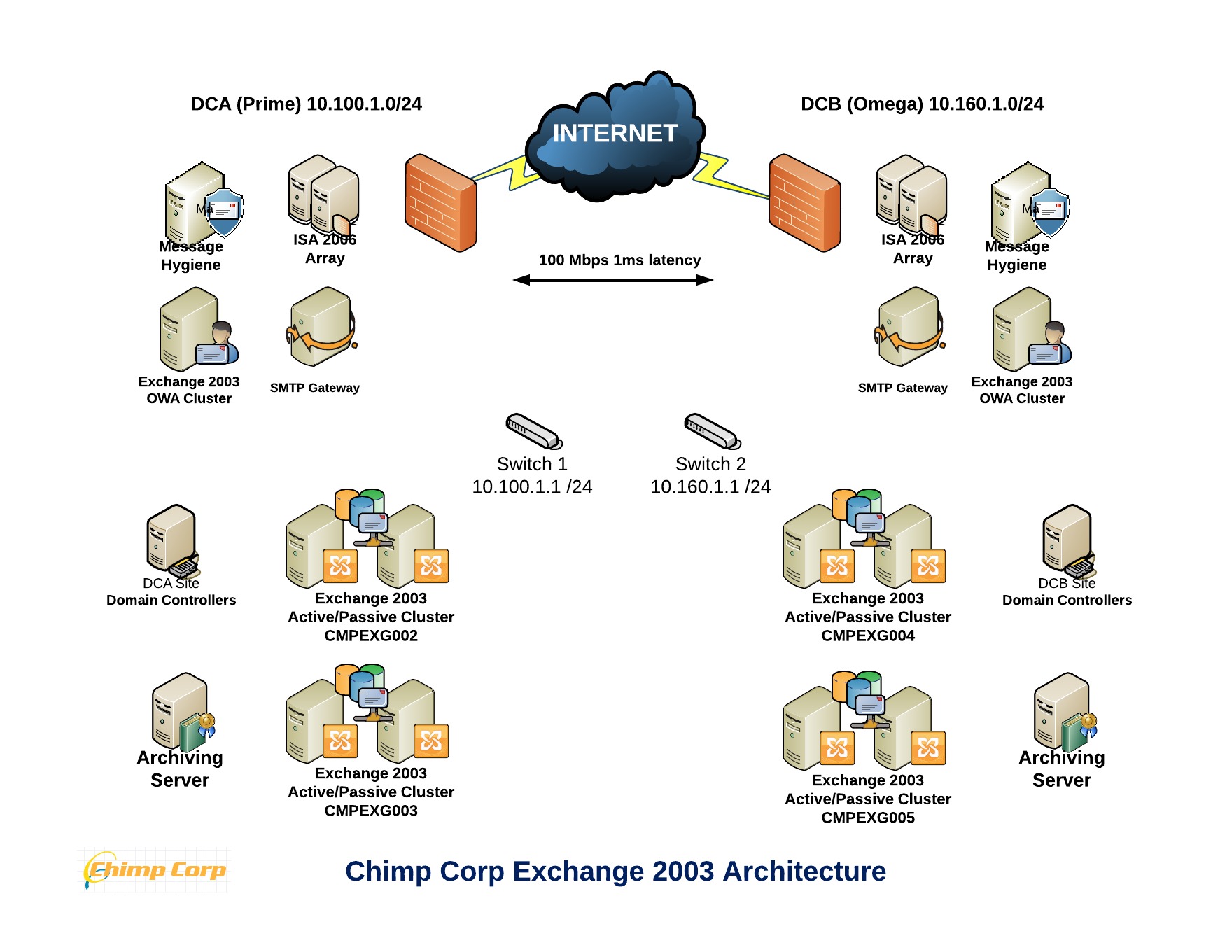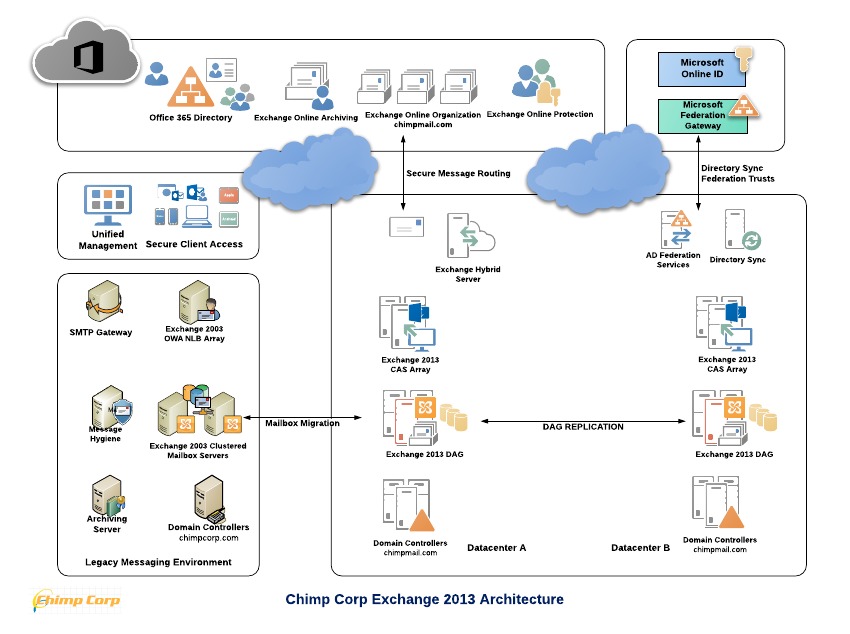Overview:
This section provides an introduction into the key elements of the Exchange 2013 Architectural solution. It provides high-level solution overview and is suitable for all technical project stakeholders. The excerpts of the final design document are listed under this post and the full High Level Design document can be downloaded here: RoadChimp Sample Architectural Doc (ADOC) v1.1
1. Messaging Infrastructure function
The Messaging Infrastructure serves the primary function of providing electronic mail (E-mail) functionality to Chimp Corporation. The messaging infrastructure supports E-mail access from network connected computers and workstations as well as mobile devices. E-mail is a mission critical application for Chimp Corp and it serves as an invaluable communications tool that increases efficiencies and productivity, both internally to an organization, and externally to a variety of audiences. As a result, it is of paramount importance for the Chimp Corp to maintain a robust infrastructure that will meet present and future messaging needs.
Key requirements of the messaging infrastructure are as follows:
- Accommodate service availability requirements
- Satisfy archiving requirements
- Satisfy growth requirements
- Provide required business continuity and disaster recovery capabilities
1.A. About IT Services (ITS)
The IT Services Organization is responsible for managing the IT environment for the Chimp Corp as well as ensuring adherence to published standards and operational compliance targets throughout the enterprise.
1.B. Service Level Agreement (SLA)
The Email infrastructure is considered mission critical and, therefore, has an SLA requirement of 99.99% availability.
The full SLA for the messaging environment can be found in the document <Link to SharePoint: Messaging SLA>
1.C. Locations
The messaging infrastructure is hosted from two separate datacenters being at:
- Datacenter A (DCA)
Chimp Center Prime
1 Cyber Road,
Big City
- Datacenter B (DCB)
Chimp Center Omega
10 Jungle Way,
Banana Town
The messaging infrastructure is supported by the IT Services Support Organization located at:
- Chimp Corp Headquarters
Chimp Center Prime
Bldg 22, 1 Cyber Road,
Big City
1.D. E-mail User Classifications
The primary users of the messaging system are Chimp Corp employees. The user base is divided in two groups as follows:
- Exec: users performing Senior or Critical corporate functions
- Normal: the rest of the user population
2. Existing Platform
This section of the Asset document provides an overview of the present state of the asset, as well as a chronological view of changes based on organizational or technological factors.
2.A. Existing Exchange 2003 design
A third-party consulting company performed the initial implementation of the messaging environment in 2000. The messaging platform was Microsoft Exchange 2003 and Windows 2003 Active Directory. The diagram below provides a representation of the existing design blueprint.
Fig. 1 Existing Messaging Environment
A single unified Active Directory Domain namespace chimpcorp.com was implemented in a Single Domain, single Forest design.
2.B. Change History
Over the years the Chimp Corp messaging environment has undergone various changes to maintain service level and improve functionality. The timeline below shows the changes over time.

Fig. 2 Chimp Corp Messaging Infrastructure Timeline
2.B.1 Initial Implementation
The Exchange 2003 messaging infrastructure was implemented by IT Services in 2005 and the entire user base was successfully migrated over to Exchange 2003 by September 2005.
2.B.2 Linux Virtual Appliances deployed for Message Hygiene
A decision was made by IT to deploy a Message Hygiene environment for the company in Windows 2013.
This change was scheduled as maintenance and was executed early 2009.
2.B.3 Additional Datacenter Site (Omega)
In order to improve infrastructure availability and to support additional growth of the corporate environment, a second datacenter site, codenamed Omega was commissioned and fully completed by March of 2009.
2.B.4 Two Exchange Mailbox Clusters (A/P) deployed in the Omega Datacenter Site
To improve the availability of e-mail for users and also to meet plans for storage and user growth, two additional Exchange Mailbox Servers were deployed in Datacenter Omega (DCB).
2.B.5 Third-party archiving solution
A third party archiving solution was deployed by IT Services in 2010 as part of efforts to mitigate growth of the Exchange Information Stores, based on recommendations from their primary technology vendor. The archiving solution incorporates a process known as e-mail stubbing to replace messages in the Exchange Information Stores with XML headers.
2.B.6 Acquisition by Chimp Corp
After being acquired by Chimp Corp in September 2011, immediate plans were laid out to perform a technology refresh across the entire IT infrastructure.
2.B.7 Active Directory 2008 R2 Upgrade
The Windows Active Directory Domain was updated to version 2008 R2 in native mode in anticipation of impending upgrades to the Messaging infrastructure. The replacement Domain Controllers were implemented as Virtual Machines hosted in the Enterprise Virtual Server environment running VMWare vSphere 5. This change was completed in March 2012.
2.C. Existing Hardware Configuration
The current hardware used in the messaging platform consists of the following elements:
2.C.1 Servers
Existing server systems comprising the messaging environment include:
- 12 x HP DL 380 G4 servers at DCA with between 2 – 4 GB of RAM
- 10 x HP DL 380 G4 servers at DCB with between 2 – 4 GB of RAM
2.C.2 Storage characteristics
Exchange storage used for databases, backups, transaction logs and public folders have been provisioned on:
- 2 TB of FC/SAN attached storage provisioned for 5 Exchange Storage Groups and 21 Databases and Transaction Logs
- 2 TB ISCSI/SAN attached storage Archiving
2.D. Network Infrastructure
The Chimp Corp email infrastructure network has two main physical locations at the DCA and DCB datacenter sites. These are currently connected via the Chimp Corp LAN/WAN. The core switches interconnecting all hardware are Cisco 6500 Series Enterprise class switches.
2.E. Present Software Configuration
Software and licenses presently in use include:
- Microsoft Windows 2003 Standard
- Microsoft Windows 2003 Enterprise
- Microsoft Exchange 2003 Standard
- Microsoft Exchange 2003 Enterprise
- Third Party SMTP Appliances
- A Stub-based third-party Email Archiving Tool
3. Messaging Infrastructure Requirements
The design requirements for the Exchange 2013 messaging environment have been obtained from the project goals and objectives, as listed in the Project Charter for the E13MAIL Project.
The primary objective for the E13MAIL Project is to ensure continued reliability and efficient delivery of messaging services to users and applications connecting to Chimp Corp from a variety of locations. Stated design goals are to increase performance, stability and align the operational capabilities of the messaging environment with Industry Best Practices.
The requirements/objectives for the messaging infrastructure are:
- Redundant messaging solution deployed across 2 datacenter locations; DCA and DCB.
- Capable of Audit and Compliance requirements
- High Availability (99.99%)
- Monitoring of services and components
- Accurate configuration management for ongoing support
- Adherence to Industry Best Practices for optimal support by vendors and service delivery organizations
- Reliable Disaster-Recoverable backups, with object level recovery options
- Message Archiving functionality with a maximum retention period of 7 years
4. Design Components
The primary messaging solution is to deploy new Exchange 2013 environment that spans Chimp Corp’s physical data center locations and extends into Microsoft’s Office 365 cloud to take advantage of the latest user productivity and collaboration features of Microsoft Office 2013.
The main goals for this solution are:
- Minimize end-user impact: Minimizing the end-user impact is a key goal for Chimp Corp. Significant effort must be made to ensure that the transition of all e-mail related services are seamless to the end-user.
- Reliable delivery of services: The messaging environment is a mission critical component of Chimp Corps IT infrastructure and adheres to strict Change Management practices. The solution must be able to integrate with existing Operational and Change processes.
- Longevity of solution: The new messaging solution must endure beyond the initial implementation as it evolves into a production state. This requires the necessary attention to ensuring that operational knowledge is transferred to IT Services technical teams such that they can maintain uptime requirements.
The individual design components were subjected to a stringent evaluation process that included the following design criteria:
- Costs of Ownership
- Technological engineering quality
- Scalability
- Fault Tolerance / Reliability
- Industry best practices
- Supportability
- Ease of administration
- Compatibility with existing systems
- Reliability
- Vendor specifications
4.A. Hardware technology
IT Services researched the server solutions from a number of hardware vendors and made a final decision in favor of HP, Brocade and Cisco vendor equipment.
4.A.1 Server hardware
The server platform used is the eighth generation (G8) HP Blade 400-series server. This is an Intel based server system. The CPUS’s in these systems are standardized to Intel Xeon E5-2640 processors; these are hex-core processors with a 2.5 GHz speed. The servers are equipped with 128 GB of memory to accommodate their specific functions. The blade servers are provisioned in HP Blade C 7000 class enclosures.
4.A.2 Storage hardware
To accommodate the storage requirements two storage arrays are implemented. The primary array is an HP EVA 6400 class Storage Area Network. This array is equipped with 25TB of RAW storage and is used for on-line, active data. The secondary array is an HP P2000 G3 MSA class storage area network. This array is equipped with 15TB of RAW storage and is used for secondary storage like archives, backups etc.
4.A.3 Interconnect technology
HP’s Virtual Connect technology is used to accommodate network connectivity to both the storage network and the data networks. The virtual connect technology acts as a virtual patch panel between uplink ports to the core switching infrastructure and the blade modules. The virtual connect backplane will connect the network connections into a Cisco based core network. The storage area network is interconnected via a Brocade switch fabric.
4.A.4 Server Operating Systems technology
The majority of the messaging infrastructure components will be deployed onto the Microsoft Windows Server 2012 Operating System platform, licensed to the Enterprise version of the operating system. For systems that do not support Windows Server 2012, Windows Server 2008/R2 will utilized.
4.A.5 Messaging platform technology
A pristine Microsoft Exchange Server 2013 will be implemented in a hybrid configuration, featuring two major components:
- On-premise Exchange 2013: The on-premise environment to support core business functions that cannot be moved to the cloud due to compliance reasons.
- Office 365: All non-compliance restricted users will be migrated onto the Office 365 cloud.
The hybrid deployment will feature full interoperability between on-premise and cloud-based users, featuring single sign-on, sharing of calendar Free/busy information and a single unified OWA login address.
4.A.6 Back-end Database technology
Microsoft SQL Server 2012 was selected as the database platform to support all non-Exchange application requirements. The selection criterion for this product was partly dictated by the usage of technologies that depend on the SQL server back-end. As part of simplification and unification, it is preferred to keep all back-end databases in the messaging infrastructure on the same database platform.
4.A.7 Systems Management Solution
Due to the diversity of software applications and hardware in this infrastructure, a mix of management tools and products are used to manage all aspects of the messaging infrastructure. Major components are listed below:
(a) Server hardware management: Vendor provided HP System Insight Manager hardware tools are used in combination with Microsoft System Center Operations Manager (SCOM) to provide hardware-level monitoring and alerting.
(b) Server event management: Microsoft Systems Center Operations Manager (SCOM) 2012 is used for server event consolidation, management and alerting.
(c) Server Applications management: Server software management comprises of systems patch management and server provisioning.
- Systems patch management: Windows Systems Update Server (WSUS) integrated into Systems Center Configurations Manager (SCCM) provides patch management of all Windows Server Operating Systems in the messaging environment.
- Server Provisioning: Server Provisioning for both bare metal and virtual server deployments are managed via the HP rapid deployment pack (HP/RDP)
4.A.8 Message Security and Protection technology
The following Security and Protection products have been selected:
- Server Virus protection: McAfee Antivirus has been selected to protect the server operating system.
- Message hygiene: Microsoft Exchange Online Protection (EOP) will be used for message hygiene and protection.
- Security events auditing: Microsoft SCOM has been selected to capture information such as security auditing and alerting events that are generated from the server platforms.
4.B. Functional Blueprint
The blueprint below illustrates the desired messaging infrastructure:
Figure 3 Chimp Corp Functional Messaging Design
Conclusion
In the next section we will cover more detailed aspects of the Exchange 2013 design, as well as Server Virtualization Considerations for deploying Exchange 2013.
For the next part of this post, please click here.



Hi. You refer to Windows 2012 Enterprise. You mean standard, right?
Its Perfect Study,